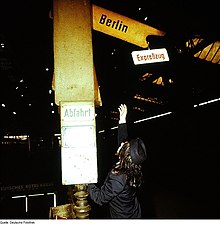express train

As express or shortly Express is usually referred to passenger trains at high speed and generally higher comfort. Many express trains run over long distances and are often used across borders.
As a train type Express (Ex) , they were in the GDR and in Austria performed. This is still the case today with the Czech state railway České dráhy and the Slovak state railway Železničná spoločnosť Slovensko ; Here the express train type stands between the Intercity and the Rychlík (ordinary express train ).
In France they ran as long-distance trains and connected both the major cities of the country with each other and smaller cities with Paris . The express trains complemented the TGV , mostly had air-conditioned cars and were hauled by diesel or electric locomotives. These trains have been known as Intercités since 2006 .
In Italy , espresso (E / EXP) was the name for a night train until 2012 . With a few exceptions, sleeping and couchette cars were used, with the option of car transport (there were also a few exceptions). In contrast to the Intercitynotte (ICN) , these trains used older material and had up to 16 cars at peak times . In addition, a few train stations were fixed stops for an espresso . For example, some pairs of trains traveling between Milan and Naples did not stop in Rome and Florence .
The term express is part of the name of many trains due to its quickly translated meaning in many countries . However, this translation does not correspond to the original meaning (namely expressly ) of the term, but is to be explained by its special use, mainly in the post office and railroad .
Furthermore, the lines 2 , 3 , 4, 5, <6>, <7>, A, B, D, E, Q, R (only in Brooklyn) of the New York City Subway are (partially) referred to as express , da skip these on three or four-track sections on the inner tracks. At important stops, they stop at central platforms with the so-called locals that stop everywhere (1, 6, 7, C, F, G, J, L , M , N, R, S ).
Trivia
Sometimes the courses of a high-speed tram line are also referred to as express trains, for example in Hanover.